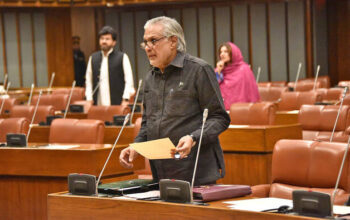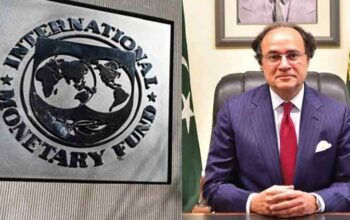By Staff Reporter
ISLAMABAD: Pakistan’s economic alarm bells are still ringing loudly with fear of a global recession, spiraling local inflation, shrinking growth, and alarmingly low foreign currency, reserves stoking investor concerns over a possible economic emergency, missed targets with the International Monetary Fund (IMF) and political unrest.
The Finance Ministry said economic growth is likely to remain below the budgeted target and the “combination of low growth, high inflation and low levels of official reserves is particularly challenging for policymakers”.
Pakistan has about $5.9 billion of its foreign exchange reserves left available for key oil and other imports. Crushed by a mountain of debt, the country is facing a severe economic crisis, hammering the local currency and sending prices soaring. Many have been plunged into poverty as auto to textile manufacturers have shut down plants or cut their production to half.
The Ministry in its monthly ECONOMIC UPDATE & OUTLOOK of December said the demand management policies by the central bank and the government are “designed to fight inflation and protect official reserves and protect inclusive growth in the short-run”.
“As in many other countries, Pakistan’s economic activity remains currently below potential, implying a negative output gap. At the same time… inflation remains substantially above targets.”
“On the fiscal front, fiscal consolidation is a topmost priority to achieve targeted fiscal deficit despite the government facing the unprecedented challenge of providing relief to people in flood-hit areas,” the ministry added.
“But in the long run, the government aims to stimulate the supply side to elevate the long-run potential growth rate of the economy. Increasing the growth trends of output, per capita real incomes, and employment can only be achieved by stimulating investments in new production capacities and improving overall productivity.”
Inflation
Inflationary pressure has started easing out as the month-on-month CPI inflation declined from a massive high of 4.7 percent in October 2022 to 0.8 percent in November. Moreover, the recent government’s decision to provide relief to the masses by slashing the prices of petroleum products is expected to translate into lower costs of food and non-food for the general public.
SBP has announced an increase of 100 bps in the policy rate in order to curtail inflationary expectations. Moreover, the declining international commodity prices are expected to offset the inflation spikes that emerged due to domestic supply shocks.
Nevertheless, it can be expected that YoY CPI inflation in the month of December will maintain its declining tendency observed in November. It is expected that CPI inflation will remain in the range of 21-23 percent.
Agriculture
Standing water due to recent floods may create problems in achieving the assigned wheat sowing target, however, the federal and provincial governments are working hard and committed to enhancing wheat productivity. In addition to the timely increase in Minimum Support Price (MSP), the government has taken measures/initiatives like awareness campaigns, extension services, subsidized and quality provision of inputs (seed and fertilizers) etc, which are focused to enhance wheat productivity.
Industrial activity
Industrial activity, measured by the LSM index is the sector that is most exposed to external conditions. In October 2022, LSM output came in somewhat lower than expected on the basis of a baseline scenario. In fact, the underlying trend in LSM is still positive, but, by historical standards, its cyclical position is significantly negative. It is expected that pressure on LSM will likely sustain in November if the negative shocks continue to prevail and outpace the LSM output, which may gain momentum as sugarcane crushing starts in November.
Overall economic activity
The average Monthly Economic Indicator (MEI) during the first 5 months of the current FY points to positive but slow year-on-year economic growth. This is illustrated by the CPI inflation which remains elevated and weighs on real incomes, the further deteriorating cyclical position in Pakistan’s main trading areas, the declining growth of imports, and the negative output gap in LSM output. Also, other monthly indicators seem to confirm this development such as cement sales, automobile production
Most of the high-frequency indicators show signs of lower growth since the start of the current fiscal year as the economic situation is faced with severe headwinds both at global and domestic ends. These are reflected in the MEI which continues to remain on a lower path of economic expansion.
External
Balance of payment data indicates that exports of goods and services increased by around 1.9 percent in November as compared to October. Exports have now settled around $2.9 billion mark and are expected to climb further in the coming months so as again to restore its $3 billion mark in coming months. However, on a year-on-year basis, they decreased by 12.7 percent. Several factors are contributing to low exports for goods including a continued downward trend in the cyclical position of the main trading partners, the underlying growth trend in those countries remained bleak during 2022. Second, REER low level has implied price competitiveness for exports which cannot provide desired dividends to exports due to high RPI. Third, the domestic economic dynamism remains uncertain. The fourth and most important risk factor is geopolitical tensions, the Russia-Ukraine conflict which elevated the risks for Pakistan’s economy in terms of high international prices and significant pressure on external and fiscal accounts.
November BoP data further witnessed that the import of goods and services decreased by 5.9 percent on a month-on-month and a massive decline of 32 percent on a year-on-year basis. Contained domestic demand and higher domestic interest rates reflect in low imports for machinery, transport, textile, agriculture, and other chemicals and metal groups. It is expected that imports will settle at further lower levels gradually in the coming months. Accordingly, the trade balance of goods and services decreased by 14.8 percent on a month-on-month and 47.8 percent on a year-on-year basis.
Furthermore, the government continues on implementing measures to curb unnecessary imports and striving hard to cope with the macroeconomic imbalances and financing challenges. Along, a stabilization trend in international commodity prices, it is expected that the trade deficit will further improve in the coming months and settled down at significantly lower levels in the second half of the current fiscal year. Assuming targeted remittance inflows, the expected improvement in the trade balance will be reflected in declining current account deficits, such that these deficits remain manageable and comfortably financeable for FY2023.
Fiscal
The first four months of FY2023 have witnessed a higher expenditure growth on the back of higher mark-up payments. Currently, the government is facing the unprecedented challenge of providing relief to people in flood-hit areas. The government is providing relief through the Kisaan package and BISP. Additional spending due to flood-related activities may significant pressure on total expenditure. On the revenue side, despite import compression and a zero rating on POL products, FBR has surpassed both its 5- month target of Rs2,680 billion and its monthly target of Rs537 billion.
Copyright © 2021 Independent Pakistan | All rights reserved




